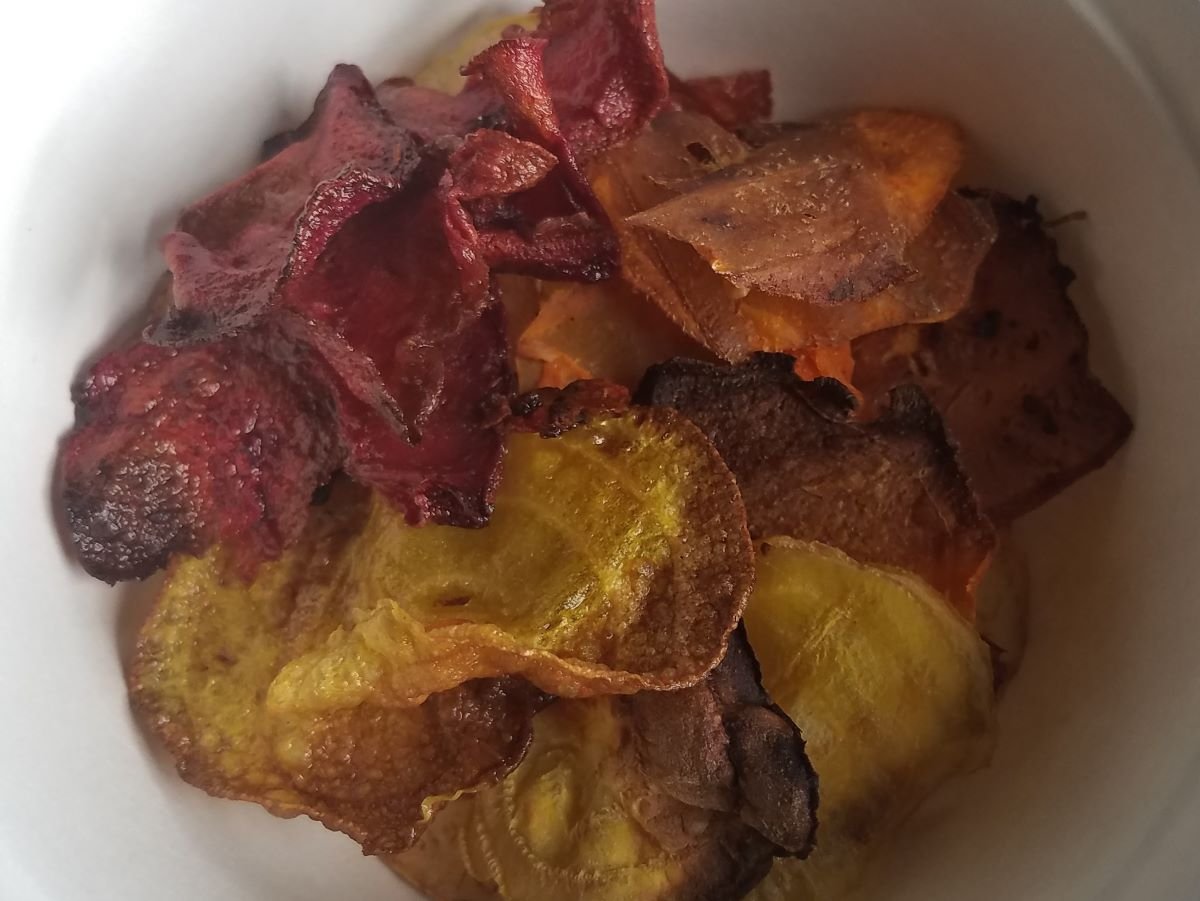Root Vegetable Chips: A Crispy, Healthy Alternative to Traditional Chips

This post may contain affiliate links. Please read my disclaimer for more information.
When it comes to snacking, few things are as satisfying as a crunchy, salty chip. But traditional potato chips often come with a side of unhealthy oils, excessive salt, and empty calories. Enter root vegetable chips—an equally crunchy but far healthier alternative that brings color, nutrition, and natural flavor to your snack time. Whether you’re looking for a healthier snack for yourself or something unique to serve at your next gathering, root vegetable chips are a fantastic option that is easy to make and customize.
What Are Root Vegetable Chips
Root vegetable chips are made from a variety of vegetables that grow underground, such as sweet potatoes, carrots, beets, parsnips, and even taro. These veggies are sliced thinly, seasoned, and baked (or fried) until they become crispy. The result is a colorful medley of chips that not only look beautiful but are packed with vitamins, fiber, and minerals. Plus, they allow you to enjoy the satisfying crunch of chips without the guilt.
Why Choose Root Vegetables?
Root vegetables are naturally nutrient-dense, offering a range of health benefits:
- Sweet Potatoes: Rich in fiber, vitamins A and C, and potassium, sweet potatoes provide a natural sweetness that makes for a perfect chip base. The high vitamin A content is excellent for skin health and vision.
- Beets: Known for their earthy flavor and vibrant color, beets are packed with antioxidants like betalains, which help reduce inflammation. They are also a good source of folate, iron, and potassium.
- Carrots: Carrots add a bright, slightly sweet flavor to the mix. They are well-known for their high beta-carotene content, which is beneficial for eye health and immune support.
- Parsnips: Parsnips offer a nutty, slightly sweet flavor. They are high in fiber and essential vitamins such as vitamin C and folate.
- Taro and Other Roots: Taro adds a unique, slightly starchy texture, perfect for a more substantial chip. It is rich in dietary fiber and resistant starch, making it great for digestive health.
Each vegetable brings its own distinct flavor, color, and nutritional value, making these chips a versatile and health-conscious snack option.
How Root Vegetable Chips Compare to Regular Chips
The biggest difference between root vegetable chips and conventional chips lies in both the nutritional profile and the cooking method. Regular potato chips are often deep-fried in unhealthy oils, leading to high levels of saturated fats and calories. They’re also usually loaded with salt and preservatives.
In contrast, root vegetable chips:
- Lower in Fat: Baking the chips instead of frying significantly reduces fat content, especially if you’re using heart-healthy oils like olive or avocado oil.
- Packed with Nutrients: Different root vegetables offer a diverse range of nutrients, from vitamins and minerals to antioxidants and fiber. These nutrients are largely absent in regular potato chips.
- Less Processed: Homemade root vegetable chips allow you to control what goes into your food, keeping out artificial additives and preservatives often found in commercial chips.
- Naturally Sweet and Flavorful: Many root vegetables have a naturally sweet or earthy flavor, so they require less added salt to taste delicious.
Simple Seasoning and Preparation
While traditional chips often rely on salt as their primary seasoning, root vegetable chips can be seasoned in endless ways to bring out their natural flavors. Here are a few simple yet flavorful seasoning ideas:
- Olive Oil and Sea Salt: A classic combination that highlights the natural taste of the vegetables.
- Smoked Paprika and Cumin: Adds a smoky, earthy flavor that pairs particularly well with sweet potatoes and parsnips.
- Herbs and Garlic: Fresh or dried rosemary, thyme, or oregano with a sprinkle of garlic powder offers an aromatic, savory touch.
- Cinnamon and Nutmeg: For a sweeter twist, try cinnamon and nutmeg on sweet potatoes for a warm, comforting flavor.
- Chili and Lime: A bit of chili powder with a spritz of lime juice adds a tangy, spicy kick, perfect for pairing with beets or carrots.
How to Make Root Vegetable Chips
The process of making root vegetable chips is simple and only requires a few ingredients: your choice of root vegetables, a healthy oil, and your favorite seasonings. Here’s a basic outline of the process:
- Prep the Veggies: Wash and peel your root vegetables. Using a mandoline slicer or a sharp knife, slice them thinly to ensure they cook evenly.
- Season the Chips: Toss the vegetable slices in a small amount of oil—extra virgin olive oil or avocado oil works best—along with your choice of seasonings.
- Bake Until Crisp: Arrange the seasoned slices on a baking sheet in a single layer. Bake in a preheated oven at 375°F (190°C) for about 15-25 minutes, flipping halfway through. Keep an eye on them to prevent burning.
- Cool and Enjoy: Let the chips cool on the baking sheet for a few minutes. They will continue to crisp up as they cool. Serve fresh or store in an airtight container for up to a week.
Versatility in Snacks and Meals
One of the best things about root vegetable chips is their versatility. They can be enjoyed as a stand-alone snack or paired with a variety of dips, such as hummus, guacamole, or yogurt-based dips for added protein and flavor. You can also use them as a crunchy topping for salads or soups, adding both texture and nutritional value to your meals.
Healthy Dips to Pair with Root Vegetable Chips
- Guacamole: The creamy texture and healthy fats of avocado make this a perfect dip for root vegetable chips, especially beets and sweet potatoes.
- Hummus: A protein-rich dip made from chickpeas, tahini, and garlic. Pairing hummus with parsnip or carrot chips creates a satisfying, wholesome snack.
- Greek Yogurt and Herb Dip: A refreshing, protein-packed dip that complements the earthy tones of root vegetables like taro and beets.
- Salsa: The bright flavors of fresh tomato salsa balance the sweetness of root vegetable chips for a light, refreshing snack.
Conclusion
Root vegetable chips offer a delicious and nutritious alternative to traditional potato chips, giving you the crunch you crave without the unhealthy ingredients. By using a variety of root vegetables, you not only add color and flavor to your snack but also boost its nutritional value with essential vitamins, minerals, and antioxidants. With customizable seasonings and endless dipping options, root vegetable chips are sure to become a go-to snack for anyone looking to eat healthier without sacrificing flavor. So, next time you’re in the mood for something crunchy, ditch the bag of processed chips and whip up a batch of homemade root vegetable chips instead!

Root Vegetable Chips
Ingredients
- 2 medium beets
- 1 large turnip
- 1 large carrot
- 1 small sweet potato
- 1 medium plantain
- 1/2 teaspoon salt
- 1/2 teaspoon ground black pepper
- 1/4 teaspoon garlic powder
- 1 quart avocado oil
Instructions
- Cut, peel, and slice all vegetables using a sharp knife or a mandolin to make thin chips.
- Season sliced vegetable chips with salt and pepper. Fry chips in a deep fryer until golden brown and crispy. Or coat chips with cooking spray and bake at 400 degrees for 10 minutes until brown and crispy. Or coat chips with cooking spray and air-fry at 400 degrees until crisp.
- Keep an eye and remove the chips that brown first before they burn. Cool before eating.
